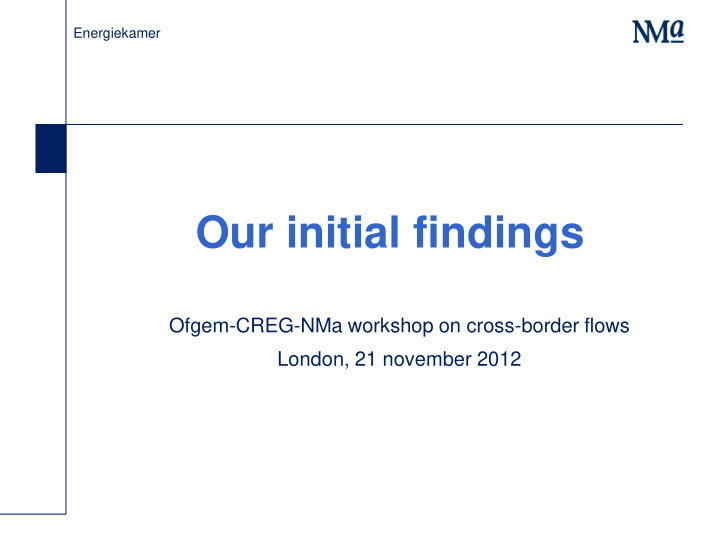



Energiekamer Our initial findings Ofgem-CREG-NMa workshop on cross-border flows London, 21 november 2012
Energiekamer Initial analysis We have examined whether or not gas trades between GB and Belgian and Dutch hubs (i.e. between the NBP and ZEE and TTF hubs) are economically efficient. We would consider cross-border trades to be economically efficient if gas flows from the low priced to the high priced market. If this is not the case, we observe flows against price differentials (“FAPDs”). We also consider that when significant price differentials are observed capacity should be used to the fullest extent. Therefore under-utilisation of capacity is an inefficiency. We believe that current and expected future developments show an ever greater need for market arrangements that ensure an efficient operation of gas interconnectors.
Energiekamer Method Actual physical flows between GB and Belgium or Netherlands on a daily basis Difference between day-ahead prices on the NBP and Zeebrugge or TTF Plot physical utilization of interconnectors IUK and BBL against price differences Establish departure from the economically efficient flow (assuming no cost of transportation)
Energiekamer IUK
Energiekamer Initial findings: IUK On IUK (excluding days on which no flow occurred on the assumption that this was due to technical reasons): Average absolute price difference (NBP:Zeebrugge) = 1.05p/th. Price spread above average on 35% of days. On 28% of days gas flowed from high- to low-priced market. Capacity not fully used on 99% of days (305 of 309) when price spread above average (1.26p/th). FAPDs on 40 of 305 days when capacity not fully utilised. Average utilisation rate = 38%. IUK has a tendency to export gas from GB to Belgium.
Energiekamer BBL
Energiekamer Initial findings: BBL On BBL (excluding days on which no flow occurred on the assumption that this was due to technical reasons): Average absolute price difference (NBP:TTF) = 1.81p/th. Price spread above average on 31% of days. On 65% of days gas flowed from high- to low-priced market. Since 2011 expansion utilisation rates have not exceeded 79%. Average physical utilisation rate = 47% (38% since 2011 expansion). Virtual flows only used 29% of the time (and only ever fully used over one day once since their introduction in 2011 and that was caused by unusually low forward flows).
Energiekamer Conclusions The initial analysis found that both interconnectors show FAPDs. – Flow direction does not always react to price signals and flows are not always economically efficient. Also both interconnectors are often not fully used. – Interconnectors are on some occasions under-utilised despite high price differentials. Both inefficiencies could be detrimental to integration of markets, cross-border trade and security of supply.
Energiekamer IRF use on BBL over time
Recommend
More recommend